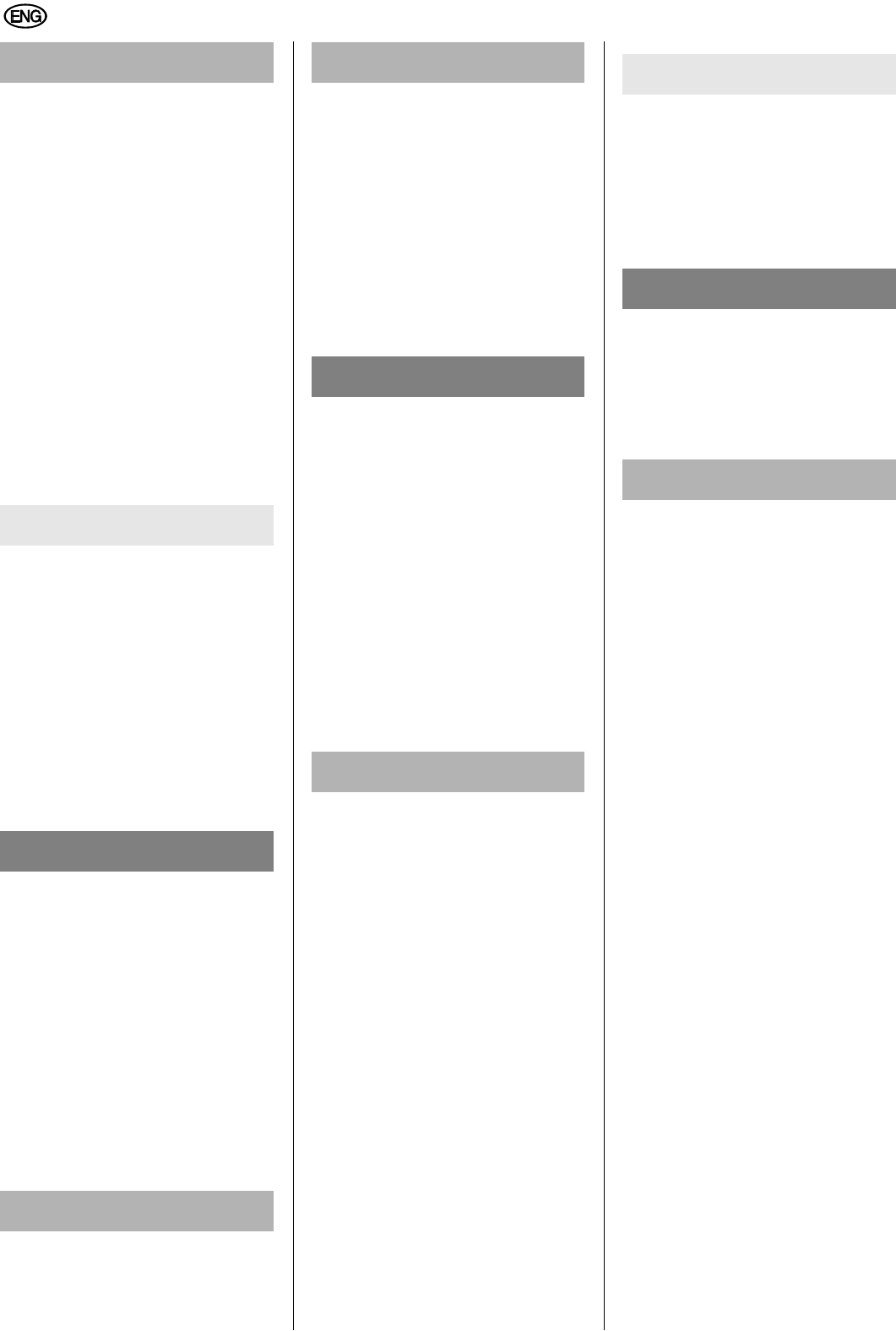
8
ENGLISH
Risk of injury by moving parts
Entanglement with the machine
Insufficient personal protection gear
Dust
x Before plugging the machine in,
check the voltage and cycle rating
(120 V, 60 Hz) on the nameplate of
the machine and make sure you
have a proper power source with
the same
rating. If not, consult a
qualified electrician for assistance.
x Be careful not to kink, squeeze or
pull the power cord and/or any
extension cord, and make sure that
you pro tect the cord(s) from dam-
age caused by rolling over
, heat,
aggressive substances like acid, or
other potential damage arising at
the work site.
x If the power cord or an extension
cord is damaged, never try to repair
it, but have a qualified electrician or
other auth
orized repair personnel
replace the damaged cord.
A CAUTION
x To avoid electrical shock, ensure
there is no contact with grounded
objects such as radiators, pipes,
ovens, refrigerators, etc. when
operating this machine.
x Ensure nobody can trip over or
inadvertently pull on the power
cord.
x Ne
ver pull on the power cord to
unplug the machine as this can
damage the cord and lead to a
hazard.
A DANGER
x Do not operate the machine with-
out installed guards.
x Make sure the power cord is
unplugged before servicing, trou-
bleshooting or changing parts.
x Remove all tools and loose parts
from the machine before plugg
ing
in and operating the machine after
service or troubleshooting.
x After completing a cut, do not let go
of the handle of the machine or
your work piece until all moving
parts of the machine have
come to
a full stop.
A WARNING
x When the machine is not in use,
switch it to OFF and unplug it.
A WARNING
x Make sure your work pieces are
secured in place during cutting so
that they cannot move.
x Work stock only in the direction
intended for the machine.
x Do not exert exessive force on the
machine with the work piece.
x Never have the machine running
unattended. Turn power OFF.
Don't leave the machine until it
comes to a full stop.
A DANGER
Be careful that no part of your body or
your clothing can be caught by and
pulled into the machine.
x Do not wear any loose clothing.
x Do not wear any gloves.
x Long hair has to be covered (for
example by
making a pony tail and
then tucking the hair in under a cap
or hat).
x Dangling jewelry, rings, bracelets,
necklaces and other personal items
which might get caught in the
machine have to be removed
b
efore starting to work with this
machine.
A WARNING
x Use eye protection. Always wear
ANSI approved impact safety gog-
gles. If you are producing metal fil-
ings or wood chips, wear a full face
shield.
x Use ear protection. Always wear
ANSI approved ear
protection such
as ear plugs or ear muffs.
x Use respiratory protection when
working around metal, wood, espe-
cially treated wood, chemical dusts
or mists. Always wear an ANSI
approved dust mask or respirator
or other respiratory protection in
accordance
with current OSHA,
MSHA and NIOSH regulations.
x Wear head protection if required by
your type of work or by regulations
applying to the job site.
x Wear protective, electrically non-
conductive clothes and non-skid
foot wear.
A WARNING
A CAUTION
x Wear suitable work clothes.
x When working outdoors wearing
of non-slip shoes is recom-
mended.
x Ensure a fire extinguisher is within
reach.
A DANGER
x DO NOT CUT ANY HAZARDOUS
MATERIALS OR MATERIALS
THAT CONTAIN HAZARDOUS
SUBSTANCES OR HAVE BEEN
TREATED WITH HAZARDOUS
SUBSTANCES.
A WARNING
x Some types of wood dust (e.g.
maple, oak, cedar) may cause
allergic reactions and other health
problems such as skin rashes, etc.
If possible, work with a suitable
dust collector connected to the
saw. The dust collector must com-
pl
y with the data stated in chapter
15, entitled "Technical Specifica-
tions".
x Dust generated by sawing, sand-
ing, drilling and similar work may
contain substances that are known
or suspected to cause cancer,
damage to reproductive organs
and/or the
ability to procreate, and/
or may cause damage to fetuses
and unborn children. Lead, lead
paint, arsenic or chromium treated
wood (often referred to as "green
wood" or pressure-treated lumber)
and quartz dust or silica from con-
crete are just some, but in no case
an e
xclusive list of such sub-
stances. The actual health risk
depends on the length of exposure
to these substances, the circum-
stances as well as the degree of
respiratory and other protection
used.


















